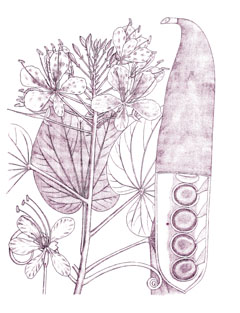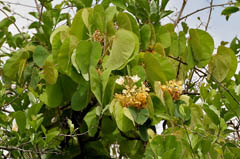 |
|
https://edibleplants.org/ |
 |
| wikimedia.org User:J.M.Garg |
Translate this page:
Summary
Malu creeper or Bauhinia vahlii is a fast-growing climbing shrub up to 30 m long and 20 cm in diameter. It can grow into tops of the trees. The seeds are tonic and aphrodisiac and the leaves are demulcent and mucilaginous. The seeds can be eaten raw or fried and cooked as a pulse. The inner bark is a source of fibre used in making ropes. The stems are used for basketry, matting, and wickerwork. The leaves are used as a thatch. Other Names:Adda, Bhorla, Chambul, Jallur, Mahulan, Maljhan, Malu, Moharain, Namarain, Sihar.
Physical Characteristics

 Bauhinia vahlii is an evergreen Climber growing to 20 m (65ft) by 1 m (3ft 3in) at a fast rate.
Bauhinia vahlii is an evergreen Climber growing to 20 m (65ft) by 1 m (3ft 3in) at a fast rate.
See above for USDA hardiness. It is hardy to UK zone 8. The flowers are pollinated by Insects.
It can fix Nitrogen.
Suitable for: light (sandy), medium (loamy) and heavy (clay) soils and prefers well-drained soil. Suitable pH: mildly acid, neutral and basic (mildly alkaline) soils. It cannot grow in the shade. It prefers moist soil.
UK Hardiness Map
US Hardiness Map
Synonyms
Bauhinia racemosa Vahl
Plant Habitats
Edible Uses
Edible Parts: Flowers Leaves Seed Seedpod
Edible Uses: Gum
Edible portion: Seeds, Pods, Leaves, Flower. The seeds are eaten raw or fried[ 287 , 317 , 668 ]. Cooked as a pulse[ 310 ]. The tender young pods and leaves are cooked as vegetables. The flower buds are eaten as a vegetable. The seeds are eaten raw, roasted, or dried and fried.
References More on Edible Uses
Medicinal Uses
Plants For A Future can not take any responsibility for any adverse effects from the use of plants. Always seek advice from a professional before using a plant medicinally.
Aphrodisiac Demulcent
The seeds are tonic and aphrodisiac[ 287 ]. The leaves are demulcent and mucilaginous[ 287 ].
References More on Medicinal Uses
The Bookshop: Edible Plant Books
Our Latest books on Perennial Plants For Food Forests and Permaculture Gardens in paperback or digital formats.

Edible Tropical Plants
Food Forest Plants for Hotter Conditions: 250+ Plants For Tropical Food Forests & Permaculture Gardens.
More

Edible Temperate Plants
Plants for Your Food Forest: 500 Plants for Temperate Food Forests & Permaculture Gardens.
More

More Books
PFAF have eight books available in paperback and digital formats. Browse the shop for more information.
Shop Now
Other Uses
Basketry Containers Fibre Gum Soil stabilization String Tannin Thatching
Other uses rating: High (4/5). Agroforestry Uses: The plant is considered to be a formidable enemy of trees in India, where it has been known to completely smother the tree into which it has grown for support[ 372 ]. It is of use on rocky or disturbed and bare slopes, where its can quickly clothe the ground and its large leaves protect the soil from erosion[ 146 ]. Other Uses A good quality fibre is obtained from the inner bark. It can be made into very strong ropes[ 287 , 317 , 454 ]. It is used for sewing straw mats with the fresh bark[ 454 ]. It can be cut in all seasons; the outer bark is stripped off and thrown away, the inner coating being used for ropes, as wanted, by being previously soaked in water and twisted when wet[ 454 ]. Before being used, the bark is boiled and beaten with mallets, which renders it soft and pliable for being made into ropes and string for charpoys[ 454 ]. The stems are used for matting, basketry and wickerwork[ 310 ]. The leaves are utilized for thatching and making umbrellas[ 317 ]. The large flat leaves are sewn together and used as plates, cups, rough tablecloths, umbrellas, cloaks, and rain capes[ 668 ]. A gum exudes copiously from the tree[ 668 ]. Of little value[ 146 ]. The bark contains up to 17% tannins[ 287 , 310 ]. The tannin cannot be extracted easily, but is of very good quality[ 310 ].
Special Uses
Food Forest Nitrogen Fixer
References More on Other Uses
Cultivation details
Grows best in a sunny position[ 200 ]. Prefers a fertile, well-drained but moisture-retentive soil[ 200 ]. The plant grows back quickly from the base when it is cut down, and has been known to produce new growth of 15 metres within 12 months[ 146 ]. This species has a symbiotic relationship with certain soil bacteria; these bacteria form nodules on the roots and fix atmospheric nitrogen. Some of this nitrogen is utilized by the growing plant but some can also be used by other plants growing nearby[ 755 ].
References Carbon Farming Information and Carbon Sequestration Information
Temperature Converter
Type a value in the Celsius field to convert the value to Fahrenheit:
Fahrenheit:
The PFAF Bookshop
Plants For A Future have a number of books available in paperback and digital form. Book titles include Edible Plants, Edible Perennials, Edible Trees,Edible Shrubs, Woodland Gardening, and Temperate Food Forest Plants. Our new book is Food Forest Plants For Hotter Conditions (Tropical and Sub-Tropical).
Shop Now
Plant Propagation
Seed
Other Names
If available other names are mentioned here
Malu creeper or Bauhinia vahlii. Other Names:Adda, Bhorla, Chambul, Jallur, Mahulan, Maljhan, Malu, Moharain, Namarain, Sihar.
Native Range
TROPICAL ASIA: India, Nepal, Pakistan (Punjab)
Weed Potential
Right plant wrong place. We are currently updating this section.
Please note that a plant may be invasive in one area but may not in your area so it's worth checking.
None Known
Conservation Status
IUCN Red List of Threatened Plants Status : This taxon has not yet been assessed.

Growth: S = slow M = medium F = fast. Soil: L = light (sandy) M = medium H = heavy (clay). pH: A = acid N = neutral B = basic (alkaline). Shade: F = full shade S = semi-shade N = no shade. Moisture: D = dry M = Moist We = wet Wa = water.
Now available:
Food Forest Plants for Mediterranean Conditions
350+ Perennial Plants For Mediterranean and Drier Food Forests and Permaculture Gardens.
[Paperback and eBook]
This is the third in Plants For A Future's series of plant guides for food forests tailored to
specific climate zones. Following volumes on temperate and tropical ecosystems, this book focuses
on species suited to Mediterranean conditions—regions with hot, dry summers and cool, wet winters,
often facing the added challenge of climate change.
Read More
Expert comment
Author
Wight & Arn.
Botanical References
Links / References
For a list of references used on this page please go here
A special thanks to Ken Fern for some of the information used on this page.
Readers comment
| Add a comment |
|
If you have important information about this plant that may help other users please add a comment or link below. Only comments or links that are felt to be directly relevant to a plant will be included. If you think a comment/link or information contained on this page is inaccurate or misleading we would welcome your feedback at [email protected]. If you have questions about a plant please use the Forum on this website as we do not have the resources to answer questions ourselves.
* Please note: the comments by website users are not necessarily those held by PFAF and may give misleading or inaccurate information.
To leave a comment please Register or login here All comments need to be approved so will not appear immediately.
|
Subject : Bauhinia vahlii
|
|
|
|